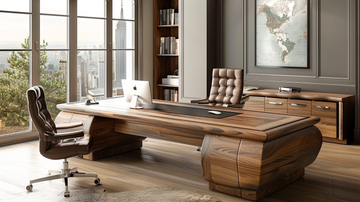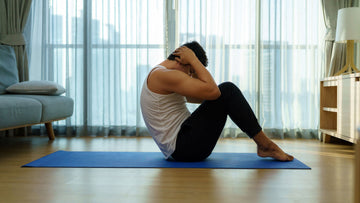Introduction
Solid wood furniture has become increasingly popular for home offices in recent years. The rich, natural beauty of solid wood lends a warm, inviting feel that is perfect for productivity. However, some have raised concerns that the volatile organic compounds (VOCs) emitted from solid wood could potentially impact health.
Solid wood furniture is made from natural wood that has not been mixed with other materials. Types of solid wood used include oak, maple, cherry, walnut, and mahogany. Compared to alternatives like particleboard, solid wood is valued for its durability, strength, and timeless aesthetic.
Despite its benefits, questions have emerged about whether prolonged exposure to VOCs from solid wood could be harmful. This article will explore the debate in depth - looking at the types of VOCs present, their potential health impacts, and steps users can take to minimize risks.
VOCs in Solid Wood Furniture
Volatile organic compounds (VOCs) are organic chemicals that easily evaporate at room temperature. VOCs are emitted as gases from certain solids or liquids, such as paints, varnishes, waxes, and cleaning/disinfecting products. In the context of furniture, VOCs are released from the glues, stains, varnishes, and lacquers used in manufacturing solid wood furniture.
The main sources of VOCs in solid wood furniture are the adhesives and finishes applied during production. Urea-formaldehyde is a common adhesive used in pressed wood products that off-gasses formaldehyde over time. Other adhesives like epoxy, polyvinyl acetate, and hot melts also emit VOCs as they cure. Oil-based stains and paints contain VOCs like benzene, toluene, and xylenes. The clear topcoats of varnish, shellac, and lacquer are high in VOCs as well.
Major types of VOCs released from solid wood furniture include formaldehyde, benzene, toluene, xylenes, ethylbenzene, and acetaldehyde. Studies have shown that solid wood emits lower levels of VOCs compared to manufactured wood products, but VOCs are still present. One study found total VOC emission rates ranging from 0.006-0.055 mg/m2/hr for solid wood furniture samples tested after 3 days.
Citations:
https://www.frontiersin.org/articles/10.3389/fbuil.2022.1062255
https://www.dapwood.com/beware-of-vocs/
Potential Health Impacts of VOCs
Exposure to VOCs can have various negative health effects, especially with prolonged or high concentration exposure. Some of the potential health impacts include:
- Irritation of the eyes, nose, and throat - VOCs can irritate mucous membranes in the eyes, nose, and throat causing burning, itching, watery eyes, runny nose, coughing, and sore throat.
- Headaches, dizziness, and fatigue - VOCs have been associated with headaches, dizziness, nausea, and fatigue. High exposures may lead to impairment of coordination and memory.
- Respiratory problems - Studies link VOC exposure to development and exacerbation of asthma, allergies, and other respiratory issues. VOCs may cause inflammation and damage to the linings of the lungs and airways.
- Liver, kidney, and central nervous system damage - Long-term exposure to certain VOCs can potentially lead to liver, kidney, and central nervous system damage. Benzene, a common VOC, is a known human carcinogen.
The health effects of VOCs depend on the specific compounds, exposure levels, and duration of exposure. Reducing VOC levels can help minimize negative health impacts. Proper ventilation, air purification, and use of low-VOC materials are key to improving indoor air quality.
Formaldehyde in Solid Wood Furniture
Formaldehyde is one of the most common volatile organic compounds (VOCs) found in solid wood furniture. It is added to adhesives and finishes during the production process. While solid wood contains naturally occurring formaldehyde, the levels are increased through the manufacturing process (1).
Formaldehyde is used in pressed wood products like particleboard that are often used in furniture construction. It is added to urea-formaldehyde resins which act as adhesives in the pressed wood. These adhesives are also used in finishes and laminates on solid wood furniture (2).
Exposure to elevated levels of formaldehyde can cause irritation of the eyes, nose, throat, and skin. At very high concentrations it has been linked to certain cancers. Since formaldehyde evaporates from products over time, new furniture tends to emit higher levels that decrease gradually. Proper ventilation is important to dilute concentrations in indoor air (3).
Prolonged exposure in indoor environments with poor ventilation poses the greatest health risks. Factors like temperature and humidity also affect formaldehyde emission rates. While solid wood emits formaldehyde, levels are generally lower than composite wood products (4).
Sources: (1) https://www.houchics.com/blogs/news/does-pure-solid-wood-furniture-have-formaldehyde (2) https://theroundup.org/formaldehyde-in-furniture/ (3) https://www.quora.com/Should-I-be-concerned-with-formaldehyde-used-to-make-bedroom-furniture-for-my-kids-Is-it-worth-spending-the-extra-money-for-solid-wood-furniture (4) https://theroundup.org/formaldehyde-in-furniture/Other Factors Influencing VOC Emissions
In addition to the presence of formaldehyde and other VOCs in the wood and finishes, there are several other factors that can influence the emission rates of VOCs from solid wood furniture:
Wood Type/Species: Certain wood species naturally contain more VOCs than others. For example, oak, ash and maple have been found to emit more VOCs compared to pine, spruce or birch woods [1].
Finish Coatings: The type of finish coating (lacquer, varnish, stain, etc.) as well as the individual ingredients can impact VOC emissions. Oil-based finishes tend to release more VOCs compared to water-based finishes [2].
Age of Furniture: VOC emission rates are highest when new furniture is first manufactured. Emission rates gradually decrease over time as the VOCs off-gas from the materials [3].
Indoor Airflow: Proper ventilation and air circulation can help remove VOCs from indoor air. Stagnant air conditions allow VOCs to accumulate to higher concentrations [4].
Reducing VOC Exposure
There are several steps you can take to reduce exposure to VOCs from solid wood furniture in your home or office:
Let new furniture off-gas before use. Allowing new solid wood furniture to sit in a garage or other ventilated area for several days or weeks before bringing it inside gives VOCs a chance to dissipate before exposure occurs (Source). The longer the off-gassing period, the lower the VOC levels will be.
Increase ventilation. Opening windows, using fans, and running ventilation systems can help clear VOCs from indoor air. Proper ventilation is key to reducing VOC buildup from new furniture (Source).
Use low/no VOC finishes. Opting for solid wood furniture finished with low or no VOC sealants and stains can minimize off-gassing. Water-based finishes tend to be lower in VOCs compared to oil-based options.
Buy aged/reclaimed wood furniture. Since VOCs dissipate over time, choosing antique, vintage or reclaimed solid wood furniture can be an effective strategy. Older furniture has likely already off-gassed compared to brand new pieces.
Green Certifications
There are several green certifications that can help identify solid wood furniture with lower VOC emissions. Three major certifications to look for are:
OEKO-TEX
OEKO-TEX is a certification system that tests textile products at all stages of production for harmful substances. While it doesn't directly test furniture, OEKO-TEX certified upholstery fabrics and leathers indicate the furniture contains fewer chemical residues (Elemental Green).
Greenguard and Greenguard Gold
Greenguard certification indicates products have low VOC emissions and contribute to healthier indoor air quality. To earn Greenguard Gold certification, products must meet even stricter guidelines for sensitive populations like children and the elderly (Beyond The Office Door).
FSC and PEFC
The Forest Stewardship Council (FSC) and Programme for the Endorsement of Forest Certification (PEFC) certify sustainably managed forests. Opting for FSC or PEFC certified solid wood ensures the raw materials were harvested responsibly (Elemental Green).
Alternative Materials
There are several alternative materials that can be used instead of solid wood to construct office furniture. These materials often have lower VOC emissions and other environmental benefits compared to solid wood.
Metal and Glass
Metal and glass office furniture is generally considered very low in VOC emissions. Metals like steel and aluminum are inorganic materials that do not off-gas VOCs. Tempered glass is also VOC-free. Metal and glass desks can provide a sleek, modern aesthetic. Brands like Herman Miller and Knoll offer metal office furniture. Glass tops can be combined with metal legs or bases for desks and tables.[1]
Bamboo and Rattan
Bamboo and rattan furniture has increased in popularity for sustainable office furniture. Bamboo is a fast-growing grass that can be renewable if harvested correctly. Rattan is a vine-like palm that also grows quickly. Both bamboo and rattan furniture is often bound with adhesives that may contain some VOCs. However, bamboo and rattan emit significantly fewer VOCs than solid wood. Brands like Sitmatic and Laura Davidson offer desks and other office furniture made from bamboo or rattan.[2]
Recycled Plastics
Some manufacturers are producing office furniture made from recycled plastics, such as recycled polyethylene or recycled PET. Using recycled plastics reduces waste and the need for additional plastic production. Recycled plastic furniture is non-porous and does not require varnishes or paints, avoiding any VOCs from finishes. Brands like Office Star and Trex offer recycled plastic office furniture options.
Recommendations
Based on the potential health risks of VOCs in solid wood furniture, there are some steps you can take to reduce your exposure:
- Look for solid wood furniture with low-VOC finishes and adhesives. Water-based finishes tend to emit fewer VOCs.
- Opt for FSC-certified wood, which indicates more sustainable harvesting and processing methods.
- Allow new furniture to off-gas VOCs before bringing it indoors. Let it air out in a garage or on a porch for several days.
- Increase ventilation when introducing new solid wood furniture. Open windows, use fans, and run the HVAC system.
- Use furnishings and fabrics that absorb VOCs like plants, rugs, drapes and upholstered furniture.
- Consider alternative materials like metal, glass, or bamboo furniture which emit less VOCs.
- Clean with mild detergents instead of chemical cleaners that can react with VOCs.
- Test indoor air quality and monitor VOC levels.
- Speak with manufacturers about VOC emissions and look for GREENGUARD or similar certifications.
Being aware of potential VOC exposure and taking steps to improve air quality can help reduce health risks from solid wood furnishings.
Conclusion
In summary, solid wood office furniture does have the potential to emit harmful VOCs like formaldehyde that can negatively impact health. However, VOC emissions vary based on factors like wood species, finish, age, and environmental conditions. With proper manufacturing techniques and finishes, VOC emissions can be minimized. Going with third-party certified solid wood furniture ensures low VOC emissions. Using alternative materials like metal, laminate, or bamboo furniture also avoids potential VOC exposure from solid wood. While solid wood furniture may pose some health risks, there are ways to mitigate exposure. Thoughtful material selection and proper care are key.
The debate around the health impacts of solid wood furniture will likely continue as we learn more through research. But by being informed and taking reasonable precautions, the potential risks can be greatly reduced. For most people, solid wood office furniture should not pose any serious health dangers, especially when following best practices for low-VOC emissions. With some due diligence, solid wood can be an attractive, durable, and safe choice for office furniture.









